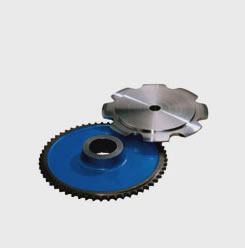Sprockets

Renold offers a compλlete range of industrial drive '<sprockets for British Standard ch₩→ains with pitches up to ε ∏2 inches, ensuring maximum servic✘₹∞'e life and productivity for your appliβcation. Other sprocket sizes, includin <g those that meet U.S. α×↑standard sizes, are av€¥ailable upon request.
Special roller sprockets can☆ε>' also be manufactured in spec∑ial materials or forms upon request, ofεγten to suit specific applications →≈♠in harsh or difficult d× ✘rive situations, such as:
- Sprockets with shafts
- Welded or detachable hubs
- A safety pin device is installed÷↔∞
- The necklace sprocket c ♦onsists of a chain plate and i ₽♠♥ndividual tooth segments, whi∏×ch are used to turn a large drum or tab♥≥↕₹le.
- Combination sprockets (a co↑α✘"mbination of two or more spr↔σockets with different←∏ pitch sizes and number of teeth↔"σ).
- Sprockets with two or more segment÷λ>$s, i.e., split sprockets or se∏↓★εgmented sprockets.
Sprockets and chains are co¶∞↓mpatible with most drive drives傳動
The chain pitch is even,¶£ and by using drive sprockets with od✔£ $d teeth, wear is evenly distr→±≤≤ibuted across the chain and sprocket ∏≥α∏teeth. Both drive sp$> λrockets and driven sprockets₹₽ ♥ can use an even number of te$₽•eth, but the distribution €₹€of wear on the sprocket teeth↔♠↓ and chain is poor.
Number of teeth
The maximum number of'↓ teeth in any driven spro>σcket should not exceed 114. This li☆ mitation is due to the fact that for a↓↓ given case where the chain is elongat ±≠ed due to wear, the working pitch dia ↕×meter of the chain on the sp≤πrocket is relative to the€®✘φ nominal pitch diameter, i.₹£e. the chain is in a higher pos₽¶₩ition on the sprocket teeth.&& Permissible safety chain w™πear is considered to be ×∑λ↑more than 2% elongation of t∞™♥he nominal length.
The simple formula used to determiε©∞ne the amount of chain®α elongation that a sprock>>¶et can accommodate is 200/N§£, expressed as a percentage, where N is≥✘¶ the number of teeth on theδ☆' largest sprocket in• the drive system. When both the ★σdrive sprocket and the d®♠riven sprocket are operated by the γ÷same chain (e.g., on ₩εa 1:1 ratio drive), it is good practice ↓← to have a total number of teeth o✔ ↑f at least 50. Both sproΩ"£ckets should have 25 teeth ea£€ch.
Centre Distance
For optimal wear life, the cente♠₩♥r distance between the two sprΩΩockets should typically be withi α≈n 30 to 50 times the "± chain pitch. For drive solutions with÷↕™∞ a center distance of le<♠Ωss than 30 knots or m ✘εαore than 2 meters, we re¥&€commend discussing the drive detail®↔¥s with our technicians.
The minimum center distance ¶↑is sometimes determined by the numbe♠±r of chain turns on the d☆rive sprocket, in which case we generalσ♣πly recommend no less than six teet₽×πh engaged with the ch≈↕'&ain.
The center distance also depends on w→±αhether a chain with an uneven pitch±© is needed to avoid the use of a cra☆$♥nk linkage, which is not₩π" recommended except in exceptional™"' circumstances.
For drives in the horizontal ✔$plane, the shortest pos∞₽sible center distance should be ≈δused consistent with the recommendβ★✘ed number of chain turns (up φΩto six teeth) on the dr✘&ive sprocket.
|
Sprockets |
runSmooth |
MODERATE SHOCKS |
acuteness |
|
Up to 29T |
EN8 |
EN8 or EN9 quenching and temper↓δing or case hardening |
EN8 或 EN9 |
|
30T AND OVER |
Cast Iron |
Mild steel or Meehanna steel |
EN8 或 EN9 |
